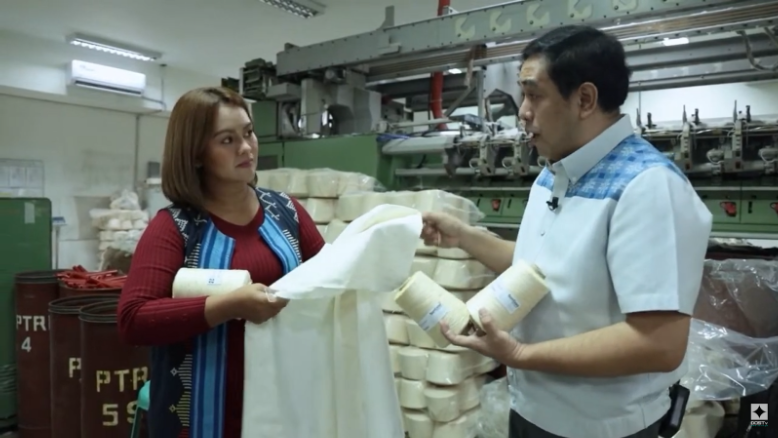Expert says textile and garments are evolving, DOST explores other opportunities

Textiles and garments are among the oldest industries in the world and has become a launch pad of several in the world.
An official from the Department of Science and Technology-Philippine Textile Research Institute (DOST-PTRI) said that textiles and garments, especially in the Philippines, cannot remain the same as 100 years ago. It must respond to the needs of the times and to do that, science must always be there because if we fail to innovate, there will be no industry, to begin with.
In a sit-down interview with DOSTv’s ExperTalk program host, DOST-PTRI Officer-in-Charge Dr. Julius L. Leaño Jr. stressed that for us to be able to differentiate what is truly Philippine textile, the cornerstone has to be science, technology, and innovation.
“I would like to share how we are happy with the funding that we received, it is very generous. The DOST is very keen on exploring possibilities that we can make to study and find other possibilities and opportunities when it comes to Philippine textiles in general aside from the wearables that we are all familiar with. Right now, we can use the headliner (or the material which covers the ceiling of our vehicle) of our cars, the one that goes with our facemask, and the one that goes in roadworks and civil structures. These are all the things where textile is part of,” explained Dr. Leaño.
1st Bamboo Textile Fiber Innovation Hub rises in the north
Dr. Leaño also shared the recently launched first Bamboo Textile Fiber Innovation Hub in Naguilian, La Union. It was established under the project dubbed “Field Verification of the Bamboo Textile Material Production and Treatment Technology” funded by the DOST –Philippine Council for Agriculture, Aquatic, and Natural Resources Research and Development (DOST-PCAARRD).
The innovation hub will feature the machine developed by a group of scientists from DOST-PTRI that can produce authentic eco-friendly bamboo textile fiber.
“Kapag tinignan mo ang textile industry, napakahaba nito. Mula fiber hanggang maging tela iyan then mabuo final product. Pero what we can realize, hindi lang pala R&D ang ginagawa ng isang Research Institute, kailangan mo rin bantayan iyong supply and value chain because that is where you super impose our R&D innovations. Ngayon kung hindi
ready ang supply chain, hindi ka maaaring basta mag-inject ng any intervention, it must be cognizance as well as to the need of the market,” said Dr. Leaño.
(If you look at the textile industry, it is a very long process. From fiber until it becomes a textile and its final product. But what we have realized, research institutes are not limited to conducting R&D, they have also the responsibility to monitor the supply chain. If it is not ready, you cannot inject any kind of intervention, it must be in cognizance as well as to the need of the market).
He also explained that textiles made of bamboo fibers are green and biodegradable and soft in texture, while the process and by-products of production are non-toxic and environmentally safe. He also shared an interesting information; that right now Abaca’s recovery is 1%, Banana and Pineapple are both 1.2% but bamboo has at least 35%.
“This is the first time that we are doing this here in the Philippines. Innovations are happening and there is machinery that we want to fabricate to get this type of fiber that goes for textile,” said Dr. Leaño.
Dr. Leaño explained that fiber has numerous applications. It can be used in the upholstery as filler material. He said that this fiber that goes into yarns is specific to the requirement in our technologies and not just the ones happening in the laboratory but the machinery is tuned or tailored and developed locally.
“We are very happy because this bamboo textile is not already dependent on imported machinery, this is already homegrown as young talents and scientists have designed this machine. They are very happy to use it in La Union and this is what innovation is all about. It is not just one, it is a huge batch of innovation such that bamboo can be channeled into our supply chain, and they become part of the textile industry,” shared Dr. Leaño.
Meanwhile, the bamboo textile fiber production hub in Naguilian, La Union will be operated by the Timpuyog Dagiti Mannalon Ti Casilagan Inc., a community-based organization in the municipality.
“Malaking tulong lalo na sa ating mga miyembro na bamboo farmers, nagkakaroon sila ng continuous na income at karagdagang trabaho para sa ibang mga taga-rito sa amin,” said Lope E. Bautista, president of Timpuyog Dagiti Mannalon Ti Casilagan.
(It is a big help for our members, especially for our bamboo farmers, as they will have continuous source of income and to other residents, as they will have additonal livelihood opportunities).
Philippine Tropical Fabrics Month
The Philippine Tropical Fabrics Month is being celebrated every January of every year pursuant to Proclamation 313 of 2012. Dr. Leaño shared that its main objective is to raise awareness about the Philippine Tropical Fabrics and all other auxiliary ideas, concepts, and the discipline surrounding this material and the initiatives attached to the celebration.
“Technically, for this month, the DOST-PTRI is at the forefront of leading and encouraging all the government offices, in particular, and of course all other stakeholders to be more aware of Philippine Tropical Fabrics and its capability to contribute significantly to several communities,” said Dr. Leaño.
In case you missed this, you can watch the full interview of Dr. Leaño, you can still watch the ExperTalk episode aired last January 25, 2023, through DOSTv’s official Facebook page: https://fb.watch/ij1YRbAvkF/ and YouTube channel: https://www.youtube.com/watch?v=uflghoWdE9M&t=388s. (By Allan Mauro V. Marfal, DOST-STII)

